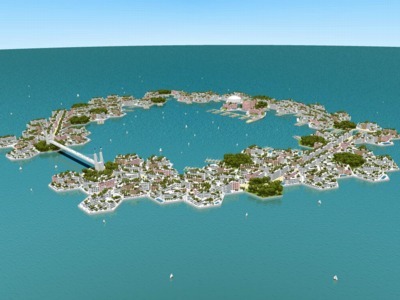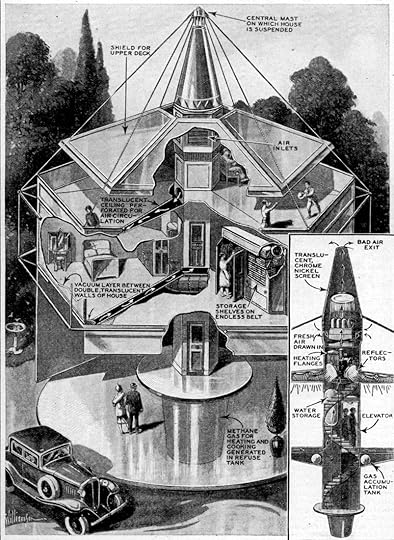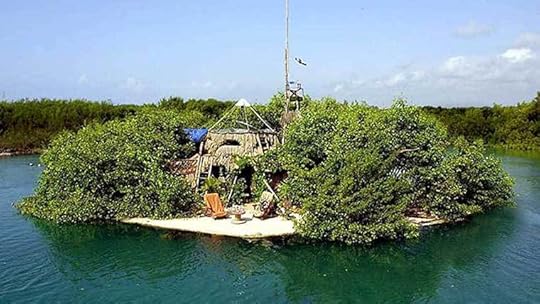The Wacky World of Seasteading – Part One

Apologies in advance for the wall of text. This post is the first in a series about seasteading and I’m posting it for a couple of reasons:
‘Seasteading’ and ocean-based communities are a central idea in the Pac Fish series
I got what I consider to be the most well-packed resource of information about the topic that I’ve ever seen.
If you’ve ever been curious about communities on the ocean, this post is for you. I learned a lot, even though I’ve researched this topic in depth for book research. Now I’m passing it along to you.
Here’s how this all started. You might have heard the recent news: Pete Thiel is no longer pursuing his vision of seasteading – creating autonomous governments on ocean-based communities. That’s significant to me, since the Pac Fish series is pretty much about people who live on those types of communities, although it’s rather different from Mr. Thiel’s vision.
So people were talking about this article on Reddit. That’s when I ran across Eric Hunting’s comments and my ears perked up. I read his post and thought, ‘wow, dude knows what he’s talking about.’ No matter what, you should read his post because he references Libertatia, which figures heavily into the new Uncharted 4 game by Playstation that I’m playing right now.
Anyway. Because I’m curious, I sent him a message:
Greetings!
I’m Dan and I write a sci-fi series about a kid who lives in a semi-autonomous ocean-based community. I talk about a lot of the same issues you discussed, but through the lens of a slacker teenager who doesn’t really understand what’s going on. I’d love to get your take on it – do you think we could talk?
Best wishes, Dan
Thus began a long-form discussion about Flotilla, seasteading and why it hasn’t gone mainstream yet. As far as I can tell, most media surrounding seasteading is either slanted toward ‘This is why we should seastead immediately’ or ‘look at the dumb weirdos who want to live on the ocean.’ There doesn’t seem to be a lot of objective ‘here’s what you should know about seasteading’-type information.
Until now.
I found the conversation incredibly insightful from the perspective of seasteading and you may as well, if you’re into that kind of thing. Let’s spend a few blog posts now talking about the science of seasteading with a guy who has actually thought this through. Later, we’ll talk about how he feels about Flotilla and the Pac Fish series. I think you’ll enjoy that, too!

So Who is Eric Hunting and Does He Know What He’s Talking About?
I started out by asking Eric, “What did or do you do with seasteading these days? I have a cordial but not close relationship with seasteading.org and I’m curious as to what your relationship with them is.” Here’s his reply:
I was long involved in the First Millennial Foundation/Living Universe Foundation and eventually became its last president. The FMF was formed to pursue the space development scheme proposed by futurist Marshal Savage in the book The Millennial Project. Perhaps the last of the ‘classic’ space futurist books.
 One of TMP’s most unique features as a space development scheme was a phase of marine settlement development called Aquarius ( http://radio-weblogs.com/0119080/images/Gallery/aquarius1.jpg ) centered on the creation of an equatorial mid-ocean marine colony that would be host of Ocean Thermal Energy Conversion plants, industrial scale mariculture, and serve as an integral part of a space transportation infrastructure. This concept emerged at about the same time in the late 1980s as several competing marine colonization concepts; Seasteading (proposed by west coast Libertarians), Oceania (proposed by Floridian Libertarians) ( http://radio-weblogs.com/0119080/images/Gallery/oceania1.jpg ), Autopia Ampere (proposed by the mercurial and eccentric inventor Dr. Wolf Hilbertz, which was partly an inspiration for the original Aquarius concept)( http://1.bp.blogspot.com/-YoX7Z9Lc7Ns/UamOLoyDdMI/AAAAAAAAA1U/ViEJGJB0bOc/s1600/AutopiaAmpere.jpg ), New Utopia or Nutopia (proposed by the eccentric entrepreneur Prince Lazarus Long and his followers in the Extropian community, which would evolve into today’s Transhumanist community)( http://www.new-utopia.com/s10.jpg ), and Nexus. (proposed by the organic architecture guru Eugene Tsui)( http://www.eugenetsui.com/slideshows/protocols/large/22D1740D-C559-439A-A079.jpg ) Also relating to this was Jacque Fresco’s Florida based Venus Project, which featured marine development ( http://antimatrix.org/Convert/Books/Jacque_Fresco_Designing_the_Future/img/Jacque%20Fresco%20-%20Designing%20the%20Future-73.jpg ) but focused chiefly on its planned land city concept. (its marine settlement designs lifted for use in Disneyworld’s Horizons exhibit–not that Fresco himself didn’t lift a lot of concepts from the Metabolist design movement…)
One of TMP’s most unique features as a space development scheme was a phase of marine settlement development called Aquarius ( http://radio-weblogs.com/0119080/images/Gallery/aquarius1.jpg ) centered on the creation of an equatorial mid-ocean marine colony that would be host of Ocean Thermal Energy Conversion plants, industrial scale mariculture, and serve as an integral part of a space transportation infrastructure. This concept emerged at about the same time in the late 1980s as several competing marine colonization concepts; Seasteading (proposed by west coast Libertarians), Oceania (proposed by Floridian Libertarians) ( http://radio-weblogs.com/0119080/images/Gallery/oceania1.jpg ), Autopia Ampere (proposed by the mercurial and eccentric inventor Dr. Wolf Hilbertz, which was partly an inspiration for the original Aquarius concept)( http://1.bp.blogspot.com/-YoX7Z9Lc7Ns/UamOLoyDdMI/AAAAAAAAA1U/ViEJGJB0bOc/s1600/AutopiaAmpere.jpg ), New Utopia or Nutopia (proposed by the eccentric entrepreneur Prince Lazarus Long and his followers in the Extropian community, which would evolve into today’s Transhumanist community)( http://www.new-utopia.com/s10.jpg ), and Nexus. (proposed by the organic architecture guru Eugene Tsui)( http://www.eugenetsui.com/slideshows/protocols/large/22D1740D-C559-439A-A079.jpg ) Also relating to this was Jacque Fresco’s Florida based Venus Project, which featured marine development ( http://antimatrix.org/Convert/Books/Jacque_Fresco_Designing_the_Future/img/Jacque%20Fresco%20-%20Designing%20the%20Future-73.jpg ) but focused chiefly on its planned land city concept. (its marine settlement designs lifted for use in Disneyworld’s Horizons exhibit–not that Fresco himself didn’t lift a lot of concepts from the Metabolist design movement…)
 There was no real rivalry among these concepts and their communities and they shared and communicated various ideas and supporters. Thus there were supporters of Seasteading on the periphery of the FMF. This brought me some peripheral involvement with the Seasteaders as they adopted some concepts I had been developing for TMP. Originally, the Seasteading community was focused on a crude concept of marine homesteading very similar to that of Richart Sowa’s Spiral Island ( http://www.sensationslife.in/sites/default/files/u15/spiral-artificial-island.jpg ) based on repurposed plastic waste, and thus dangerously non-seaworthy. At the time I was working on the logistics problems with Marshal Savage’s original Aquarius concept which had become a serous stumbling-block for its community. Savage’s original proposal was based on a static float structural system with structures cultured in water using the Hilbertz electrolytic sea accretion process. But duplicating Hilbertz’ purported results with the technique proved impossible as he had greatly exaggerated, if not fabricated, his research data. The reliance on static float structures also proved to be a critical problem as it compelled the prefabrication of a vast breakwater structure whose own creation compelled the development of a vast network of coastal eco-village communities that proved untenable as they required some of the most remote or expensive coastal real estate in the world. Dubbed Aquarius Rising, these communities were to be started with a prototype in the Maldives called Anlagen–a location largely inaccessible to most of the FMF community even as a vacation venue. The ‘pharaonic’ nature of the Aquarius phase and the decades of development it demanded grew into a major bone of contention among space cadets who always want their seat in Captain Kirk’s chair yesterday.
There was no real rivalry among these concepts and their communities and they shared and communicated various ideas and supporters. Thus there were supporters of Seasteading on the periphery of the FMF. This brought me some peripheral involvement with the Seasteaders as they adopted some concepts I had been developing for TMP. Originally, the Seasteading community was focused on a crude concept of marine homesteading very similar to that of Richart Sowa’s Spiral Island ( http://www.sensationslife.in/sites/default/files/u15/spiral-artificial-island.jpg ) based on repurposed plastic waste, and thus dangerously non-seaworthy. At the time I was working on the logistics problems with Marshal Savage’s original Aquarius concept which had become a serous stumbling-block for its community. Savage’s original proposal was based on a static float structural system with structures cultured in water using the Hilbertz electrolytic sea accretion process. But duplicating Hilbertz’ purported results with the technique proved impossible as he had greatly exaggerated, if not fabricated, his research data. The reliance on static float structures also proved to be a critical problem as it compelled the prefabrication of a vast breakwater structure whose own creation compelled the development of a vast network of coastal eco-village communities that proved untenable as they required some of the most remote or expensive coastal real estate in the world. Dubbed Aquarius Rising, these communities were to be started with a prototype in the Maldives called Anlagen–a location largely inaccessible to most of the FMF community even as a vacation venue. The ‘pharaonic’ nature of the Aquarius phase and the decades of development it demanded grew into a major bone of contention among space cadets who always want their seat in Captain Kirk’s chair yesterday.
I proposed alternative structures based on more conventional, if still potentially marine-sourced, concrete and geopolymer materials using a recently developed structural system called Pneumatically Stabilized Platforms being marketed by the firm Float Inc. This approach eliminated the need for a separate breakwater structure allowing for incremental settlement development in places more readily accessible to middle-class Americans. I suggested a new Anlagen/Aquarius Rising concept based on a near-shore floating ‘seeds’ that could grow directly into full scale colonies, which I liked to jokingly call Hyokkori Hyoutanjima–the name of an iconic Japanese puppet show whose premise was a wandering floating island. I also proposed the FMF develop some simple structures based on the ‘spar buoy’ or ‘sea tower’ structure as a way of getting their feet wet, so to speak, in marine construction. Based on the same principles as the well known FLIP research vessel, spar buoys are the smallest and simplest self-stable open sea marine structures and, though I did not consider them suited to permanent settlement development (because getting on and off them is inconvenient and it’s not possible to repair and replicate them from aboard them), they have many useful applications as science platforms, telecommunications platforms, energy facilities, down-range telemetry platforms, marine-launched rocket support structures, mobile mariculture facilities, and novel hotel and vacation housing structures. In fact, the famous oceanographer Bob Ballard had also explored a business based on using these for vacation homes. I proposed starting with a demonstration project based on a tent-like floating variation of Buckminster Fuller’s early cable-stayed 4D/Dymaxion House ( http://davidszondy.com/future/Living/dynamast02.jpg ) on a spar pylon.

The Seasteaders soon adopted both these concepts, though at first they were much more interested in the spar buoy concept than PSPs, which they seemed reluctant toward because those structures compelled a large minimum starting scale. For a long time the spar structure was the icon of the Seasteading concept. For some years they did give me credit for these concepts on their web sites and I corresponded with some of their members, though I was never invited to join their group because I’ve always been rather outspoken against the Randian faction of Libertarianism and a proponent of much more communitarian sea and space development strategies. In recent years the Seasteaders have shifted in favor of progressively large communal structures akin to the PSP and sharing features common to Aquarius and Oceania designs, slowly coming to realize the logistics issues of marine living and the large economies of scale of their likely solutions.
None of the marine settlement concepts of the late ’80s were ever able to achieve critical mass and most have not survived to the present. In many cases, their advocacy groups collapsed from within due to interpersonal conflicts Libertarian groups are prone to. Such was the case with Oceania which self-destructed in conflict over the drafting of a community constitution. Nutopia suffered from the eccentricities of its Extropian Libertarian founders and Lazarus Long’s somewhat dubious business arrangements. Autopia Ampere suffered from its inventor’s  own tempestuous personality and died with him. Nexus, with its zoomorphic organic design, was just too fanciful and strange to attract much interest. (organic design is probably the most polarizing of aesthetic movements) Once the most promising and vital of the lot, Aquarius, and the larger TMP, lost its early momentum with the abandonment by its founder over a never explained personal conflict and, despite my own decades of effort, never could overcome the space advocacy community’s inability to grasp the sea’s role in space development or the point to cultural and intentional community development, as well the movement’s more general decline toward a retrofuturist cargo cult.
own tempestuous personality and died with him. Nexus, with its zoomorphic organic design, was just too fanciful and strange to attract much interest. (organic design is probably the most polarizing of aesthetic movements) Once the most promising and vital of the lot, Aquarius, and the larger TMP, lost its early momentum with the abandonment by its founder over a never explained personal conflict and, despite my own decades of effort, never could overcome the space advocacy community’s inability to grasp the sea’s role in space development or the point to cultural and intentional community development, as well the movement’s more general decline toward a retrofuturist cargo cult.
So that’s the story of my involvement with the Seasteaders. Hope you found it of interest. I’d be happy to answer any other questions.
Boom!
Mind. Blown. I learned more from this guy about the history of seasteading in one email than I have in all my hours of research on the Internet. Seasteading covers many topics including technology, transhumanism, and politics. As with many other parts of the ocean, the real story is what happens below the surface.
So, cool discussion about seasteading but we’re only getting started. Stay tuned for Part II, in which we start plumbing the depths of other practical challenges that seasteading has tried to overcome. Hope you found this useful – I certainly did!
To be Continued …
Thanks for hanging out with me today. If you like seasteading and science fiction that takes you seriously, I hope you’ll give my first book Flotilla a shot. I’m working on its sequel right now.
Best wishes,
Dan
 newest »
newest »




At least not since the dawn of the Industrial Revolution.
Seventy percent of the Earth's surface is covered with water, so you've got a very rich source of material. Eighty percent of the world's population still live with a day's commute from rivers, ocean shorelines, so there should be interest (even if the market has been dormant for a while).
Better to start your series before millions are forced from their homes in the sinking archipelago of Florida, or the new inland sea encroaches across what was once Louisianna and Mississippi.